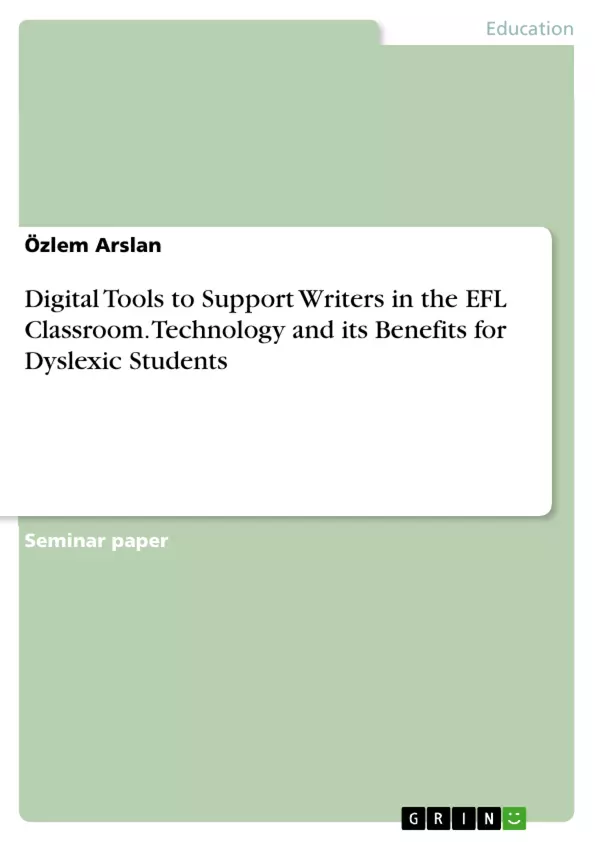The increased use of digital tools in the EFL class and the inclusion of special education needs students into classrooms sets the question how the use of digital media in the foreign language classroom impacts special education needs students. Does it enhance or impede their abilities, especially their abilities in writing, in the foreign language learning process?
The modern society can be characterized as a technology based information society. Therefore, it should be no surprise that there is an increased use of digital tools in many classrooms. As an example, foreign language teachers make use of a wide range of electronically based technology resources to allow for an authentic foreign language experience in the classroom.
However, there is another factor which foreign language teachers have to take in account when including digital media in their lessons; the inclusion of special education needs students. In the year 2006 a political document, named Convention of the United Nations on the rights of persons with disabilities, came into force in New York and was signed by 167 states. This document promotes for the non-discrimination of of people with disabilities and demands the change of the structure of the whole society. Since its publication it has led to the beginning of many changes in different areas of life; especially in education. From an educational point of view the most important articles in this document are §24 2a and §24 2b which declare the right of persons with disabilities to have equal access to education at primary and secondary schools. In 2009 Germany ratified the Convention of the United Nations on the rights of persons with disabilities and with that started the implementation of inclusive classrooms.
Inhaltsverzeichnis (Table of Contents)
- Introduction and Motivation
- Dyslexia
- Definition, Causes and Implications
- Dyslexia in the EFL Classroom
- Support of Dyslexic Students in the Classroom in General and in the EFL Classroom
- Digital Tools in the EFL Classroom
- Benefits of Digital Tools for Dyslexic Students
- Evaluation of selected Digital Tools
- Conclusion and Perspectives
Zielsetzung und Themenschwerpunkte (Objectives and Key Themes)
This paper aims to explore the advantages and disadvantages of digital tools in inclusive EFL writing classes, focusing specifically on dyslexia, a learning disability that impacts written language acquisition. It examines the definition, causes, and implications of dyslexia in the EFL classroom, highlighting methods to support dyslexic students. The paper further investigates the benefits of digital tools for dyslexic students in the EFL writing class and evaluates selected digital tools suitable for this purpose. Finally, it concludes by summarizing the findings and discussing future prospects of digital tools in the EFL writing class.
- Digital tools and their impact on inclusive EFL writing classes
- The definition, causes, and implications of dyslexia in the EFL classroom
- Methods to support dyslexic students in the EFL classroom
- Benefits of digital tools for dyslexic students in the EFL writing class
- Evaluation of selected digital tools for dyslexic students in the EFL writing class
Zusammenfassung der Kapitel (Chapter Summaries)
- Introduction and Motivation: This chapter introduces the growing use of digital tools in classrooms, particularly in foreign language education, and highlights the importance of inclusive education for students with special needs, including dyslexia. It emphasizes the need to understand how digital tools affect the learning process of dyslexic students in the EFL writing class.
- Dyslexia: This chapter defines dyslexia, exploring its causes, implications, and the challenges it presents for dyslexic learners in the EFL classroom. It discusses various symptoms of dyslexia, including difficulties in reading, writing, spelling, and other areas, emphasizing the need for tailored support strategies.
- Digital Tools in the EFL Classroom: This chapter examines the potential benefits of digital tools for dyslexic students in the EFL classroom, highlighting how these tools can support writing skills and enhance the learning experience. It discusses the evaluation of specific digital tools suitable for dyslexic learners in the EFL writing class.
Schlüsselwörter (Keywords)
This paper focuses on the intersection of digital tools, inclusive education, and the challenges faced by dyslexic students in EFL writing classes. Key themes include the benefits of digital tools for dyslexic learners, the evaluation of specific digital tools, and the implications of digital technology for supporting inclusive EFL writing instruction.
- Arbeit zitieren
- Özlem Arslan (Autor:in), 2019, Digital Tools to Support Writers in the EFL Classroom. Technology and its Benefits for Dyslexic Students, München, GRIN Verlag, https://www.hausarbeiten.de/document/512679


